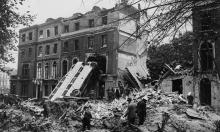The Blitz was a Nazi bombing campaign targeting London. It was designed to break the spirit of the British. Knowing London would be the centerpiece of the campaign, the British rather hastily established several psychiatric hospitals for the expected panic in the streets. However, despite 9 months of bombing, 43,000 civilians killed and 139,000 more wounded, the predicted chaos in the streets did not manifest. Civilians continued to work, industry continued to churn, and eventually, Hitler’s eye turned east toward Russia.
The surprising lack of pandemonium in London inspired Dr. John T. MacCurdy, who chronicled his findings in a book The Structure of Morale, more recently popularized in Malcolm Gladwell’s David and Goliath. A brief summary of Dr. MacCurdy’s theory divides the targeted Londoners into the following categories:
- Direct hit
- Near miss
- Remote miss
The direct hit group was defined as those killed by the bombing. However, As Dr. MacCurdy stated, “The morale of the community depends on the reaction of the survivors…Put this way, the fact is obvious, corpses do not run about spreading panic.”
A near miss were those for whom wounds were inflicted or loved ones were killed. This group felt the real repercussions of the bombing. However, with 139,000 wounded out of a city of 8 million people, they were a small minority.
The majority of Londoners, then, fit into the third group – the remote miss. These people faced a serious fear, but survived, often totally unscathed. The process of facing that fear without having panicked or having been harmed, then, led to “a feeling of excitement with a flavour of invulnerability.”
Therefore, rather than a city of millions running in fear in the streets, requiring military presence to control the chaos, London became a city of people who felt themselves, perhaps, invincible.
A similar threat passed through the world in the first several months of the COVID-19 pandemic. Hospitals were expected to be overrun, and ethics committees convened to discuss allocation of scarce ventilators. However, due, at least in part, to the impressive efforts of the populace of the United States, the majority of civilians did not feel the burden of this frightening disease. Certainly, in a few places, hospitals were overwhelmed, and resources were unavailable due to sheer numbers. These places saw those who suffered direct hits with the highest frequency. However, a disease with an infection fatality ratio recently estimated at 0.5-1%, with a relatively high rate of asymptomatic disease, led to a large majority of people who experienced the first wave of COVID-19 in the United States as a remote miss. COVID-19’s flattened first peak gave much of the population a sense of relief, and, perhaps, a “flavour of invulnerability.”
An anonymous, but concerned, household contact wrote The New York Times and illustrated perfectly the invulnerable feelings of a remote miss:
“I’m doing my best to avoid social contact, along with two other members of my household. We have sufficient supplies for a month. Despite that, one member insists on going out for trivial reasons, such as not liking the kind of apples we have. He’s 92. I’ve tried explaining and cajoling, using graphs and anecdotes to make the danger to all of us seem ‘real.’ It doesn’t take. His risk of death is many times greater than mine, and he’s poking holes in a lifeboat we all have to rely on. What is the correct path?”
American culture expects certainty from science. Therein lies the problem with a new disease no medical provider or researcher had seen prior to November 2019. Action was required in the effort to slow the spread with little to no data as a guide. Therefore, messages that seemed contradictory reached the public. “A mask less than N-95 grade will not protect you,” evolved to, “everyone should wear a homemade cloth mask.” As the pandemic evolved and data was gathered, new recommendations were presented. Unfortunately, such well-meaning and necessary changes led to confusion, mistrust, and conspiracy theories.
Psychologists have weighed in regarding other aspects of our culture that allow for the flourishing of misinformation. A photograph even loosely related to the information presented has been shown to increase the initial sense of trustworthiness. Simple repetition can also make a point seem more trustworthy. As social media pushes the daily deluge of information (with pictures!) to new heights, it is a small wonder misinformation remains in circulation.



